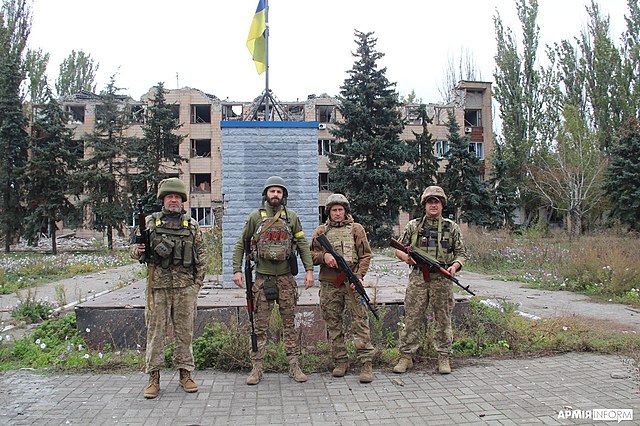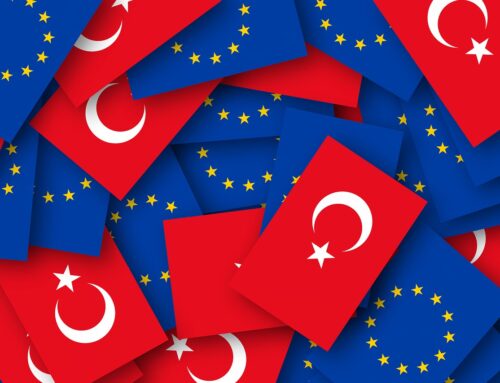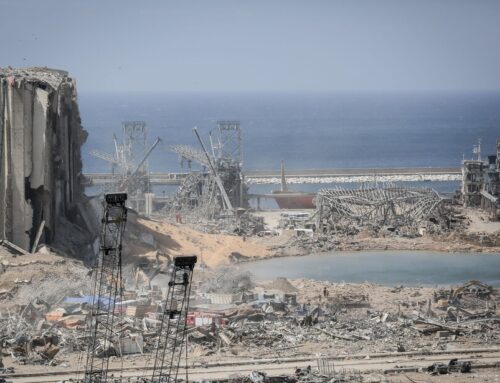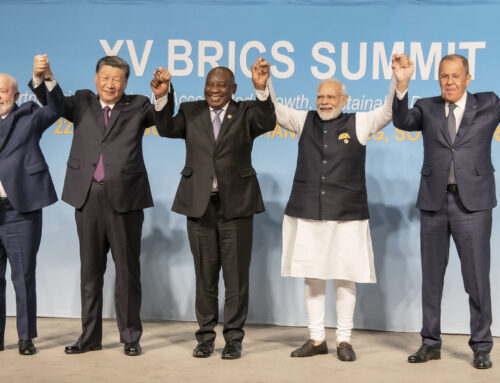PULASKI POLICY PAPER Ukrainian Offensive Operations in 2022 Strategic Context Capabilities Risks and Likely Scenarios
Autor foto: Domena publiczna

Ukrainian Offensive Operations in 2022: Strategic Context, Capabilities, Risks and Likely Scenarios
August 11, 2022
Author: P. Burkovskyi, O. Haran




PULASKI POLICY PAPER Ukrainian Offensive Operations in 2022 Strategic Context Capabilities Risks and Likely Scenarios
Autor foto: Domena publiczna
Ukrainian Offensive Operations in 2022: Strategic Context, Capabilities, Risks and Likely Scenarios
Author: P. Burkovskyi, O. Haran
Published: August 11, 2022
Pulaski Policy Paper no 14, August 11, 2022
Started on 24 February 2022, Russian invasion ended a “hybrid” period of armed aggression against Ukraine’s independence, democracy and policy of integration with EU and NATO. After five and a half months of war, despite huge losses and early failures, Russia shows no intention to scale back its offensive operations. Although underequipped and constrained with deficit of resources, the Ukrainian army plans to regain all territories lost since 2014. That is why it is important to look at the likely scenarios of the war and assess what feasible Western actions can influence it in the near future.
Strategic Context
Russia: goals and achievements
By the end of July 2022, Russia has not achieved any major alleged goal of the war:
- Elimination of the regular Ukrainian army;
- Control of the major Ukrainian cities: Kyiv, Kharkiv, Odesa, Dnipro, Zaporizhzhia;
- Destruction or capture of the Ukrainian critical infrastructure: power generation (nuclear, except in Zaporizhzhia, and most thermal power plants), seaports (except Mariupol and Kherson), airfields, gas transportation system and major oil and gas wells;
- Establishment of the pro-Russian central government;
- Disintegration of Ukraine and annexation of the southern Ukrainian regions stretching from the proxy Donbas “republics” to the unrecognized Transnistrian enclave.
At the same time, Russia faces challenges those likelihood was believed to be low before the war:
- Heavy economic sanctions: arrested national reserves, gradual disconnection of the Russian banks from SWIFT, exclusion of Russian oil and gas from European market, ban on the import of the cutting edge technologies, exit of the western oilfield services companies;
- Enhancing security and defence cooperation in the Euro-Atlantic area: planned enhancement of the US forces in Europe and accelerated re-arming of the Central European nations;
- Eventual NATO enlargement after accession of Sweden and Finland;
- Hostile neutrality of Turkey: closure of the Bosphorus and Dardanelles Straits, increased delivery of assault drones to Ukraine, establishment of humanitarian sea corridor for the Ukrainian exports;
- Accelerated transition of the Ukrainian Armed Forces (UAF) to the NATO armament standards and expedited transfer of modern western weapon systems (artillery, air defence and anti-ship missiles) to Ukraine.
To sum it up, Russia has troubles with quality and quantity of its most developed and valued military power instruments. Russian authorities have better chances to guide and control adaptation of the society to the incoming isolation and decline of general welfare. However, due to the course of the war they lack tools and certainty that they can achieve the results, which pay off all hardships.
Ukraine: goals and achievements
Since 24 February Ukraine surprised Russian and western allies with remarkable performance vis-à-vis the Armed Forces of Russian Federation (AFRF) by:
- Breaking Russian plans to eliminate Ukrainian Air Force and anti-aircraft defence;
- Forcing AFRF to retreat from the northern Ukraine after a failed attempt to take Kyiv;
- Defeating Russian Navy in the northern Black Sea waters, retaking the Snake Island and achieving multilateral agreement about the international humanitarian corridor for the grain export from three ports of the Odesa region.
Meanwhile, Ukraine faces serious threats to its near and long-term survival:
- Determination of the Russian authorities to continue the war despite failures;
- Russian intentions to annex territories, seized after February 24, which constitute 20% of the country (including Crimea and Donbas);
- Lack of assets to protect the biggest cities and economic hubs (Kharkiv, Zaporizhzhia, Dnirpo, Mykolaiv, Odesa) from gradual destruction;
- Vulnerability of the critical infrastructure to the Russian missile attacks;
- Huge outflow of labour force to EU;
- Growing poverty and economic burden of Internally displaced people (IDPs) relocation and adaptation;
- Absence of plan for transition to the war time economy amid critical dependence of external financial support and debt relief,
Right now Ukraine is entering the fourth and the worst economic crisis in the last thirteen years, which means very painful adaptation. However, despite loss of the territory the political leadership and the Ukrainian Armed Forces punched above their weight. Successful defensive operations produced paramount social confidence in victory and strong understanding of the necessary cost of the national survival. Russian war crimes played important role in persuading Ukrainian society that there are no good alternatives to complete elimination of the Russian armies.
Assessment of capabilities and losses
Air power
Russia still enjoys air and air-defence superiority on the tactical and operational level. Before February 24, according to foreign (domestic) sources, UAF had 29 (60) ground attack aircrafts, 26 (48) heavy and 43 (72) light fighters. According to the Ukrainian defence experts, before February 24 AFRF had a fleet of functioning warplanes: 131 interceptors, 193 ground attack aircrafts, 247 heavy and 64 light fighters, 127 modern and 296 Soviet-time light bombers, as well as 124 heavy bombers. According to the official Ukrainian military sources, ARRF concentrated around 67% of the whole battle ready air fleet near the Ukrainian borders before the invasion. Russia lost around 20% of its total air battle fleet or 31% of planes prepared for invasion after the five months of war.
Independent analysis of the Ukrainian air power losses shows that 36 warplanes were destroyed which amounts to 37% of the conservative and 20% of the optimistic pre-war air power assessment. It means that Ukraine is more dependent of anti-aircraft assets to repel Russian attacks and has little chances to break Russian domination in the air even in one of the key theatres of the war (Kharkiv theater, Donetsk theater, Zaporizhzia theater, Kherson theater).
Ground forces
Before 24 February, according to Ukrainian estimates, Russia could form from 146 to 168 battalion tactical groups (BTGs), composed of infantry, tanks, artillery, airborne assault troops, Special Forces and Marines. In the beginning of invasion, AFRF moved 60 BTGs inside Ukraine. After beginning of Donbas offensive BTGs number increased to 76 in April and 106 in May (or 170,000 troops without Russian proxies from occupied Donbas), although 50% of them Russia had to concentrate in Zaporizhzhia and Kherson regions to control and defend territories, seized in the first month of the war.
Meanwhile, before the invasion UAF had around 204,000 battle ready troops (official and expert estimates). By June 2022, Ukraine defence forces included 110,000 of territorial defence units (auxiliary ground force) and mobilized around 300,000 persons, mostly veterans of 2014-2021 Donbas campaign and ex-conscripts. They are supported by 90,000 National Guard forces (counter-subversion, rapid response to airborne assaults) and 60,000 Border Guard forces.
Both Ukraine and Russia do not disclose their total losses. At the same time, they demonstrate different approaches to public evaluation of the casualties inflicted to adversary. From the very beginning, Russian MoD exaggerated the Ukrainian losses (material and territorial) in order to impress both domestic and foreign audiences. The Ukrainian General Staff tried to present verified data, although the reports were more optimistic than independent assessments.
By the end of July, US intelligence estimated unrecoverable Russian losses at 75,000 killed, wounded and missed in action, which constitute around 30% of the invasion armies, including two corps of the so-called “DNR/LNR”.
According to the Ukrainian estimates, AFRF has lost around 41,000 KIA and 90,000 wounded. It must be admitted that this figure is comparable to the size of the Russian proxy troops in the occupied Donbas (approximately 35,000) before February 24. Considering the fact that the 50% of estimated total losses happened after Kremlin ordered offensive in Donbas (April12-14, 2022) it means that AFRF exhausted “local” human resources and have to rely only on the recruitment in Russia.
On the other hand, the UAF suffered considerable losses too. According to the Ukrainian MoD, the UAF lost approximately 50% of pre-war operational heavy weapons: 1,300 AFV-IFV-APC, 400 tanks (out of 800-900 before February 24), 700 artillery systems. There are no accurate data about human losses but one can estimate them around 30,000-32,000 thousand, which is 15% of the total pre-war combat ready the UAF potential, though only 5% of the whole defence forces that confronted Russian invasion since February.
As of July 26, 2022, firepower and armour capabilities of the ground forces of the Ukrainian Armed Forces (UAF) cannot match respective capabilities of the Armed Forces of Russian Federation. Moreover, the Ukrainian long-range artillery is under transition to the NATO systems and munitions,which limits its battle ready capacities and makes the UAF dependent on intensity of the western supplies and security of the supply routes and depos inside Ukraine. At the same time, AFRF are suffering from logistic and manpower issues, especially, deficit of the low and middle rank officers with relevant training and combat experience.
Resources and risks
Mass mobilization and the role of private military companies
The Russian media, especially ultra-putinist outlets, demand to launch mass mobilisation campaign inside the country. They argue that significant increase of the ground forces will deliver a decisive victory in the eastern and southern Ukraine.
However, there are few sources of manpower. The Russian opposition sources revealed that the Kremlin approved a concealed recruitment campaign focused on ex-servicemen and inmates, imprisoned for the heavy crimes. These two categories will become a backbone of the mercenary units, formed by the so-called “private military companies”, which are run and controlled by the Russian security services. Mercenary units are described as better motivated and capable compared with the regular army. Although they can make difference on the tactical level, their numbers are insufficient to play decisive role in big offensive operations.
In addition, Russian authorities are going to coerce as many conscripts as possible to sign the contracts with the army. Consequently, they will become eligible for service in the combat units in Ukraine. So far, analysis of the open Russian sources shows that recruitment campaign is failing in the regions that border Ukraine (Kursk, Voronezh, Rostov), in the Russian north-western areas, Ural industrial heartland, as well as in some Caucasus regions (Dagestan, Ingushetia). It shows that great casualties matter and a new fruitless offensive will make “special operation” unpopular among the potential recruits across the country.
Supply of the western weapons.
So far, Ukraine received 78,000 tonnes of military equipment and munition from NATO countries. The biggest donors are USA, UK and Poland. Former economic partners of Russia like Germany,Italy and France are contributing to military assistance to Ukraine in response to the Russian attempts to seize Donbas.
Russian pledges to continue the war until collapse of Ukraine. Massive war crimes and violations of humanitarian agreements can persuade members of G7, NATO and EU that only complete defeat of the Russian armies can change behaviour of the Kremlin. Therefore, in the coming months it is highly likely that volumes and quality of the western military assistance will increase.
Use of the weapons of mass destruction
During five months of war, Russia used a number of WMD delivery means, specifically, short-range ballistic missiles (Iskander), intermediate range cruise missiles (X-101, 3M-54 Kalibr) and air-to-surface cruise missiles (X-22, X-32) to hit military and civilian targets inside Ukraine. It means that the Russian military command can develop and report to Kremlin about the best delivery option for nuclear strike against Ukraine. It is likely that Russian leadership consider such move to coerce the western countries to stop weapons delivery to Ukraine (strike near Ukrainian western border) or eliminate key command & control centres (strike in the Central Ukraine or Kyiv). However, in both cases there are huge risks that Ukraine’s and western reaction will be opposite.
Scenarios for offensive actions from both belligerents
1. Russia is still capable to launch the third big offensive in the next three-four months. One scenario is immediate offensive toward one of the key cities with the help of the last battle ready/regrouped reserves. A better option is to wait until November-December to use freshly trained conscripts and mercenaries, recruited between April and July, to form new 40 BTGs, merge them with 30-35 reserve BTGs and start several offensive operations in order to disguise major objective.
2. Ukraine faces a difficult choice: by November, it will restore pre-war quantity of artillery and armour battle ready units due to mobilisation and re-training, which means that the UAF have good chances to repel new Russian offensive in the end of the year. Or it can risk with the last reserves (including Air Force) and partially retrained mobilised units merged with battle-hardened assault troops to defeat Russians in one the key theatres.
As a result, there is a classic “prisoner dilemma” situation, when both belligerents can decide rationally to wait until the end of the year for enforcements but lose risky opportunity to defeat the enemy now. Both sides try to deceive the opponent. Russia is blackmailing with “annexation” of the occupied territories, using terrorist tactics against Ukrainian cities and threatening with WMD strikes. Meanwhile Ukraine demonstrates growing superiority due to increasing supplies of the sophisticated modern western weapons, including warplanes and long-range guided missiles (up to 300 km), and threatens to strike military targets inside the Russian territory.
War theaters
Kharkiv-Donbas (likely Ukrainian and Russian offensive)
Kharkiv, the second largest Ukrainian city and vibrant economic centre before the war, in case of Russian offensive can repeat a fate of Mariupol. Siege of Mariupol showed that around 4,000 defenders could effectively resist up to 16,000 assault elite enemy troops with air and maritime fire support. In case of Kharkiv Russian offensive require to have concentrated up to 40,000 storming troops with half of air fleet to subdue any the UAF attempts to break the siege. At the same time, it is unlikely to achieve success if Ukrainian troops can counterattack from northwest and west of the city.
For Ukraine, complete liberation of the Kharkiv region creates opportunities to force retreat of the Russian forces from Donbas. If successful, this offensive will destroy Kremlin’s ideological justification of the war and expose Putin’s personal responsibility for military defeat.
Zaporizhzhia-Kherson (likely Ukrainian and Russian offensives)
Since April Russian troops experience growing pressure from the Ukrainian counterattacks in the parts of Kherson region located on the right bank of the Dnipro river and resistance movement in steppe districts of Zaporizhzhia region around Melitopol. Almost 50 Russian BTGs are dispersed in two regions to protect “land bridge” between Russia and the occupied Crimea. However, it is not an easy target for UAF unless it concentrates majority of the western-supplied artillery and risks its best air force units to break Russian defence lines.
Moreover, a threat to Crimea can give a boost to domestic mobilisation campaign in Russia, while the western allies could pull the strings to avoid “growing risk” of nuclear confrontation. In this case, Ukraine needs a kind of “blitzkrieg” operation hoping to provoke chaos inside Kremlin and coerce it to immediate ceasefire and peace talks.
On the other hand, Russia could try to siege the city of Zaporizhzhia and target the city of Dnipro with long-range artillery bombardment. In both cases, the UAF will be joined by the trained, motivated and well-equipped local territorial defence units, which can effectively disrupt local logistics routes of Russians and turn every height, forest and village in the fortified strongholds. It is likely to result in another pyrrhic victory and forced retreat to pre-offensive positions.
Western Ukraine-Belarus (likely Russian offensive)
Although self-proclaimed president of Belarus Alexandr Lukashenka is at pains to avoid direct involvement in the war with Ukraine, he is completely dependent on Russian financial and security support. The only likely objective of the second invasion from Belarus is cutting transportation lines between Ukraine and Poland, which means abandoning Ukrainian plans of offensive in the south and Donbas.
Conclusion
1. Although many external experts see current situation in Ukraine as approaching a stalemate and taking form of a “long war”, both Ukraine and Russia can choose between starting sudden offensive before September and preparing for offensive in the end of the year.
2. Russia is becoming more isolated with deteriorating military might; Ukraine is struggling with dire economic and social consequences of invasion. Therefore, offensive of the Ukrainian Armed Forces is a breaking point when the victory brings huge benefits to Ukraine and allows to avoid social and economic troubles.
3. The West, namely US together with other G7 and NATO members, plays crucial role in defining near future of the war. If Ukraine matches Russia in the air power, air defence sphere and obtains short-range high precision strike capabilities (against terrain and sea targets), then Ukraine will be ready to begin offensive operation before Russia can gather and prepare the new offensive army formation.
4. In practical terms, it means that the end of war is achievable if the West accepts scenario of Russian defeat and speeds up supplies of all necessary material means (warplanes, armour, artillery, missiles) to Ukrainian Armed Forces.
Authors: Petro Burkovskyi, Executive Director, Democratic Initiatives Foundation, Prof. Olexiy Haran, National University of Kyiv Mohyla Academy
The Paper was prepared in cooperation with International Centre for Ukrainian Victory
This paper is based on the information accumulated from the Ukrainian, Russian and Western open sources with the help of machine learning tool “Semantrum”. It does not contain confidential information and reflects only views and analysis of the authors.





